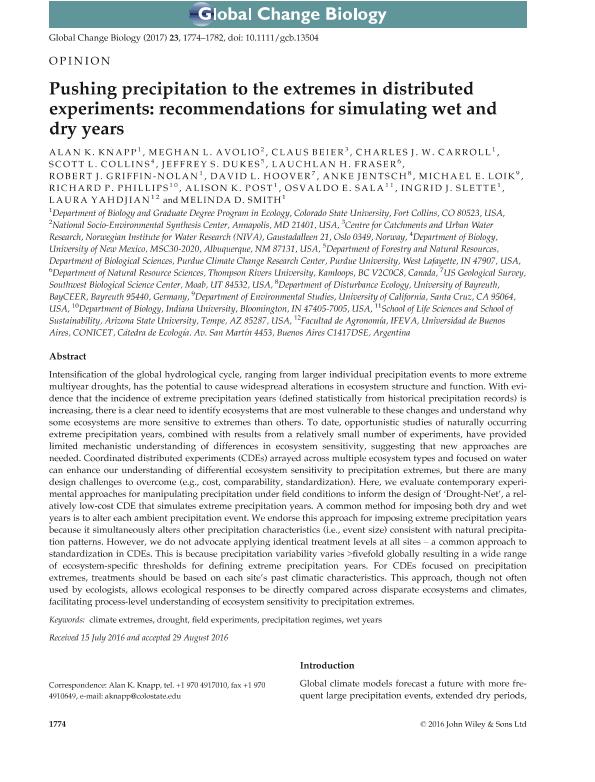Mostrar el registro sencillo del ítem
dc.contributor.author
Knapp, Alan K.
dc.contributor.author
Avolio, Meghan L.
dc.contributor.author
Beier, Claus
dc.contributor.author
Carroll, Charles J. W.
dc.contributor.author
Collins, Scott L.

dc.contributor.author
Dukes, Jeffrey S.
dc.contributor.author
Fraser, Lauchlan H.
dc.contributor.author
Griffin Nolan, Robert J.
dc.contributor.author
Hoover, David L.
dc.contributor.author
Jentsch, Anke
dc.contributor.author
Loik, Michael E.
dc.contributor.author
Phillips, Richard P.
dc.contributor.author
Post, Alison K.
dc.contributor.author
Sala, Osvaldo Esteban

dc.contributor.author
Slette, Ingrid J.
dc.contributor.author
Yahdjian, María Laura

dc.contributor.author
Smith, Melinda D.
dc.date.available
2018-07-06T15:51:16Z
dc.date.issued
2017-05
dc.identifier.citation
Knapp, Alan K.; Avolio, Meghan L.; Beier, Claus; Carroll, Charles J. W.; Collins, Scott L.; et al.; Pushing precipitation to the extremes in distributed experiments: recommendations for simulating wet and dry years; Wiley Blackwell Publishing, Inc; Global Change Biology; 23; 5; 5-2017; 1774-1782
dc.identifier.issn
1354-1013
dc.identifier.uri
http://hdl.handle.net/11336/51494
dc.description.abstract
Intensification of the global hydrological cycle, ranging from larger individual precipitation events to more extreme multiyear droughts, has the potential to cause widespread alterations in ecosystem structure and function. With evidence that the incidence of extreme precipitation years (defined statistically from historical precipitation records) is increasing, there is a clear need to identify ecosystems that are most vulnerable to these changes and understand why some ecosystems are more sensitive to extremes than others. To date, opportunistic studies of naturally occurring extreme precipitation years, combined with results from a relatively small number of experiments, have provided limited mechanistic understanding of differences in ecosystem sensitivity, suggesting that new approaches are needed. Coordinated distributed experiments (CDEs) arrayed across multiple ecosystem types and focused on water can enhance our understanding of differential ecosystem sensitivity to precipitation extremes, but there are many design challenges to overcome (e.g., cost, comparability, standardization). Here, we evaluate contemporary experimental approaches for manipulating precipitation under field conditions to inform the design of ‘Drought-Net’, a relatively low-cost CDE that simulates extreme precipitation years. A common method for imposing both dry and wet years is to alter each ambient precipitation event. We endorse this approach for imposing extreme precipitation years because it simultaneously alters other precipitation characteristics (i.e., event size) consistent with natural precipitation patterns. However, we do not advocate applying identical treatment levels at all sites – a common approach to standardization in CDEs. This is because precipitation variability varies >fivefold globally resulting in a wide range of ecosystem-specific thresholds for defining extreme precipitation years. For CDEs focused on precipitation extremes, treatments should be based on each site's past climatic characteristics. This approach, though not often used by ecologists, allows ecological responses to be directly compared across disparate ecosystems and climates, facilitating process-level understanding of ecosystem sensitivity to precipitation extremes.
dc.format
application/pdf
dc.language.iso
eng
dc.publisher
Wiley Blackwell Publishing, Inc

dc.rights
info:eu-repo/semantics/openAccess
dc.rights.uri
https://creativecommons.org/licenses/by-nc-sa/2.5/ar/
dc.subject
Climate Extremes
dc.subject
Drought
dc.subject
Field Experiments
dc.subject
Precipitation Regimes
dc.subject
Wet Years
dc.subject.classification
Otras Ciencias Biológicas

dc.subject.classification
Ciencias Biológicas

dc.subject.classification
CIENCIAS NATURALES Y EXACTAS

dc.title
Pushing precipitation to the extremes in distributed experiments: recommendations for simulating wet and dry years
dc.type
info:eu-repo/semantics/article
dc.type
info:ar-repo/semantics/artículo
dc.type
info:eu-repo/semantics/publishedVersion
dc.date.updated
2018-06-19T15:53:05Z
dc.journal.volume
23
dc.journal.number
5
dc.journal.pagination
1774-1782
dc.journal.pais
Reino Unido

dc.journal.ciudad
Londres
dc.description.fil
Fil: Knapp, Alan K.. State University of Colorado - Fort Collins; Estados Unidos
dc.description.fil
Fil: Avolio, Meghan L.. National Socio-Environmental Synthesis Center; Estados Unidos
dc.description.fil
Fil: Beier, Claus. Norwegian Institute for Water Research; Noruega
dc.description.fil
Fil: Carroll, Charles J. W.. State University of Colorado - Fort Collins; Estados Unidos
dc.description.fil
Fil: Collins, Scott L.. University of New Mexico; Estados Unidos
dc.description.fil
Fil: Dukes, Jeffrey S.. Purdue University; Estados Unidos
dc.description.fil
Fil: Fraser, Lauchlan H.. Thompson Rivers University; Canadá
dc.description.fil
Fil: Griffin Nolan, Robert J.. State University of Colorado - Fort Collins; Estados Unidos
dc.description.fil
Fil: Hoover, David L.. Southwest Biological Science Center; Estados Unidos
dc.description.fil
Fil: Jentsch, Anke. University of Bayreuth; Alemania
dc.description.fil
Fil: Loik, Michael E.. University of California; Estados Unidos
dc.description.fil
Fil: Phillips, Richard P.. Indiana University; Estados Unidos
dc.description.fil
Fil: Post, Alison K.. State University of Colorado - Fort Collins; Estados Unidos
dc.description.fil
Fil: Sala, Osvaldo Esteban. Consejo Nacional de Investigaciones Científicas y Técnicas. Oficina de Coordinación Administrativa Parque Centenario. Instituto de Investigaciones Fisiológicas y Ecológicas Vinculadas a la Agricultura. Universidad de Buenos Aires. Facultad de Agronomía. ; Argentina. Arizona State University; Estados Unidos
dc.description.fil
Fil: Slette, Ingrid J.. State University of Colorado - Fort Collins; Estados Unidos
dc.description.fil
Fil: Yahdjian, María Laura. Consejo Nacional de Investigaciones Científicas y Técnicas. Oficina de Coordinación Administrativa Parque Centenario. Instituto de Investigaciones Fisiológicas y Ecológicas Vinculadas a la Agricultura. Universidad de Buenos Aires. Facultad de Agronomía. ; Argentina
dc.description.fil
Fil: Smith, Melinda D.. State University of Colorado - Fort Collins; Estados Unidos
dc.journal.title
Global Change Biology

dc.relation.alternativeid
info:eu-repo/semantics/altIdentifier/doi/https://dx.doi.org/10.1111/gcb.13504
dc.relation.alternativeid
info:eu-repo/semantics/altIdentifier/url/https://onlinelibrary.wiley.com/doi/abs/10.1111/gcb.13504
Archivos asociados
